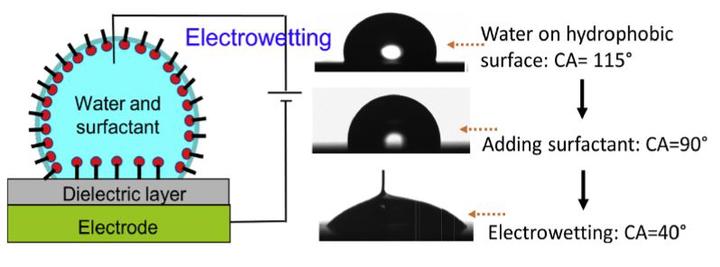Comparing electrowettability and surfactants as tools for wettability enhancement on a hydrophobic surface

Abstract
Surfactants and electrowetting (EW) are widely used for wettability enhancement of water. While numerous studies have examined the use of surfactants and EW individually, there are very few studies on electrowettability of surfactant-infused droplets. Furthermore, comparative analyses of the extent of wettability alteration via the use of surfactants and via EW are very limited. This study fills such gaps, and presents a systematic and detailed comparison of wettability control via EW and surfactants on a smooth hydrophobic surface. Nine surfactants were chosen in three categories: anionic, cationic and zwitterionic. Contact angle (CA) measurements of surfactant-infused water droplets were conducted with and without EW, at pre and post-critical micelle concentration limits (CMC).
Many fundamental insights on the interplay between surfactants and electric fields are uncovered. While surfactants enhance wettability till CMC limits, EW can enable additional CA reduction (in surfactant-infused droplets) of as much as 35°. Conversely, surfactants enhance (by as much as 27°) the EW-induced CA reduction of water-surfactant solutions, as compared to EW-induced CA reduction of water alone. Interestingly, the influence of EW in enabling CA reduction is weakened by the addition of surfactants at pre-CMC levels. In contrast, the influence of EW in enabling CA reduction is increased at higher surfactant concentrations. It is noted that the extent of wettability enhancement via EW is limited by contact angle saturation beyond a certain electric field. At post CMC levels, the saturation CAs resulting from EW are independent of surfactant concentration.